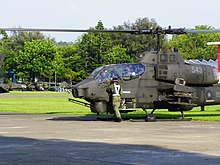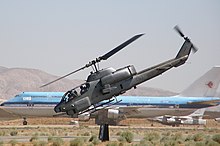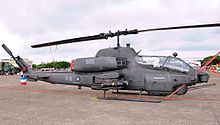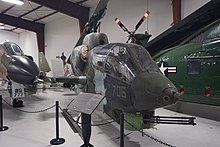Bell AH-1 SuperCobra
| AH-1 SeaCobra / SuperCobra | |
|---|---|

| |
| A USMC AH-1W taking off from USS Bataan | |
| Role | Attack helicopter |
| National origin | United States |
| Manufacturer | Bell Helicopter |
| First flight | AH-1J: 1969 |
| Introduction | AH-1J: 1971, AH-1W: 1986 |
| Retired | 2020 (USMC)[1] |
| Primary users | United States Marine Corps (former) Islamic Republic of Iran Army (former) Republic of China Army Turkish Army |
| Produced | 1970–1980s |
| Number built | 1,271+ |
| Developed from | Bell AH-1 Cobra |
| Variants | Bell AH-1Z Viper Panha 2091 IAIO Toufan |
| Developed into | Bell YAH-63 |
The Bell AH-1 SuperCobra is a twin-engined attack helicopter based on the United States Army's single-engine AH-1 Cobra. The twin Cobra family, itself part of the larger Huey family, includes the AH-1J SeaCobra, the AH-1T Improved SeaCobra, and the AH-1W SuperCobra. The AH-1W was the backbone of the United States Marine Corps's attack helicopter fleet for decades until it was replaced by the next generation Bell AH-1Z Viper.
Design and development[]
The AH-1 Cobra was developed in the mid-1960s as an interim gunship for the U.S. Army for use during the Vietnam War. The Cobra shared the proven transmission, rotor system, and the T53 turboshaft engine of the UH-1 "Huey".[2] By June 1967, the first AH-1G HueyCobras had been delivered. Bell built 1,116 AH-1Gs for the U.S. Army between 1967 and 1973, and the Cobras chalked up over a million operational hours in Vietnam.[2]
The U.S. Marine Corps was very interested in the AH-1G Cobra, but it preferred a twin-engine version for improved safety in over-water operations, and also wanted a more potent turret-mounted weapon. At first, the Department of Defense had balked at providing the Marines with a twin-engine version of the Cobra, in the belief that commonality with Army AH-1Gs outweighed the advantages of a different engine fit. However, the Marines won out and awarded Bell a contract for 49 twin-engine AH-1J SeaCobras in May 1968. As an interim measure, the U.S. Army passed on 38 AH-1Gs to the Marines in 1969.[3] The AH-1J also received a more powerful gun turret. It featured a three-barrel 20 mm XM197 cannon based on the six-barrel M61 Vulcan cannon.[4]

The Marine Corps requested greater load carrying capability in high temperatures for the Cobra in the 1970s. Bell used systems from its Model 309 to develop the AH-1T. This version had a lengthened tailboom and fuselage with an upgraded transmission and engines from the 309. Bell designed the AH-1T to be more reliable and easier to maintain in the field. The version was given full TOW missile capability with targeting system and other sensors. An advanced version, known as the AH-1T+ with more powerful T700-GE-700 engines and advanced avionics was proposed to Iran in the late 1970s, but the overthrow of the Shah of Iran resulted in the sale being canceled.[4]
In the early 1980s, the U.S. Marine Corps sought a new navalized helicopter, but it was denied funding to buy the AH-64 Apache by Congress in 1981. The Marines in turn pursued a more powerful version of the AH-1T. Other changes included modified fire control systems to carry and fire AIM-9 Sidewinder and AGM-114 Hellfire missiles. The new version was funded by Congress and received the AH-1W designation.[4] Deliveries of AH-1W SuperCobras totaled 179 new-built helicopters plus 43 upgrades of AH-1Ts.[5]
The AH-1T+ demonstrator and AH-1W prototype were later tested with a new experimental composite four-blade main rotor system. The new system offered better performance, reduced noise and improved battle damage tolerance. Lacking a USMC contract, Bell developed this new design into the AH-1Z with its own funds. By 1996, the Marines were again not allowed to order the AH-64.[4] Developing a marine version of the Apache would have been expensive and it was likely that the Marine Corps would be its only customer.[2] They instead signed a contract for upgrading AH-1Ws into AH-1Zs.[4]
The Bell AH-1Z Viper features several design changes. The AH-1Z's two redesigned wing stubs are longer with each adding a wingtip station for a missile such as the AIM-9 Sidewinder. Each wing has two other stations for 70 mm (2.75 in) Hydra rocket pods, or AGM-114 Hellfire quad missile launcher. The Longbow radar can be mounted on a wingtip station.[2] The AH-1W version was phased out of the Marine Corps in October 2020.[6][1]
Operational history[]
United States[]

During the closing months of the United States' involvement in the Vietnam War, the Marine Corps embarked the AH-1J SeaCobra assigned to HMA-369 (now HMLA-369) aboard Denver, Cleveland, and later Dubuque, for sea-based interdiction of the Ho Chi Minh Trail in North Vietnam in the vicinity of Hon La (Tiger) Island. These were termed Marine Hunter-Killer (MARHUK) Operations and lasted from June to December 1972.[7]
Marine Cobras took part in the invasion of Grenada, during Operation Urgent Fury in 1983, flying close-support and helicopter escort missions. Two Marine AH-1Ts were shot down and three crew members killed.[4] The Marines also deployed the AH-1 off the coast of Beirut, Lebanon in 1983, during that nation's civil war. The AH-1s were armed with Sidewinder missiles and guns as an emergency air defense measure against the threat of light civil aircraft employed by suicide bombers.[8]
The AH-1W variant entered service with the USMC in 1985 and 1986.[9]
USMC Cobras provided escort in the Persian Gulf in the late 1980s while the Iran–Iraq War was ongoing. The Cobras sank three Iranian patrol boats while losing one AH-1T to Iranian anti-aircraft fire.[4] USMC Cobras from Saipan flew "top cover" during an evacuation of U.S. and other foreign citizens from Liberia in 1990.[4]
During the Gulf War, 78 Marine SuperCobras deployed, and flew a total of 1,273 sorties in Iraq[10] with no combat losses. However, three AH-1s were lost to accidents during and after the combat operations. The AH-1W units were credited with destroying 97 tanks, 104 armored personnel carriers and vehicles, and two anti-aircraft artillery sites during the 100-hour ground campaign.[4]
Marine Cobras provided support for the U.S. humanitarian intervention in Somalia, during Operation Restore Hope in 1992–93. They were also employed during the U.S. invasion of Haiti in 1994. USMC Cobras were used in U.S. military interventions in the former Yugoslavia in the 1990s, and two AH-1Ws assisted in the rescue of USAF Captain Scott O'Grady, after his F-16 was shot down by a SAM in June 1995.[11]
AH-1 Cobras continue to operate with the U.S. Marine Corps. USMC Cobras were also used in operations throughout the 1990s.[4] USMC Cobras have also served in Operation Enduring Freedom in Afghanistan and in Operation Iraqi Freedom in the conflict in Iraq. While new replacement aircraft were considered as an alternative to major upgrades of the AH-1 fleet, Marine Corps studies showed that an upgrade was the most affordable, most supportable and most effective solution for the Marine Corps light attack helicopter mission.[12]
During the 2003 invasion of Iraq, 46 of 58 USMC Cobras took battle damage, mostly from infantry-type weapons.[13]
On 19 September 2011, a USMC AH-1W crashed during training exercises at Camp Pendleton, California, killing the two crewmen on board.[14] An investigation into the crash determined that it was caused by bird strike.[15] The aircraft collided with a red-tailed hawk, the impact damaging the pitch change link which in turn produced vibrations to the rotors so fierce that they caused the transmission and rotors to break off from the helicopter body.[15]
In late August 2016, Marine AH-1W Cobras flying from USS Wasp started flying combat missions over Sirte, Libya against the Islamic State of Iraq and the Levant in Libya, providing close air support for friendly militias on the ground.[16] In the later stages of the operation, AH-1Ws flew combat missions from the deck of USS San Antonio after that ship replaced Wasp in October 2016.[17]
In October 2020, the U.S. Marine Corps retired the AH-1W after 34 years of service, replacing it with the AH-1Z Viper. The Marines received 179 Super Cobras from 1986 to 1999 which flew 933,614 hours.[1][18]
Iran[]

In 1971, Iran purchased 202 examples of an improved AH-1J, named "AH-1J International", from the United States.[19] This improved Cobra featured an uprated P&WC T400-WV-402 engine and stronger drivetrain. Recoil damping gear was fitted to the 20 mm M-197 gun turret, and the gunner was given a stabilized sight and even a stabilized seat. Of the AH-1Js delivered to the Shah's Imperial Iranian Army Aviation, 62 were TOW-capable.[20]
Iranian AH-1Js participated in the Iran–Iraq War—which saw the most intensive use of helicopters in any conventional war.[21] Iranian AH-1Js (particularly the TOW-capable ones) were "exceptionally effective" in anti-armor warfare, inflicting heavy losses on Iraqi armored and vehicle formations. In operations over the barren terrain in Khuzestan and later in southern Iraq, beside the standard tactics, Iranian pilots developed special, effective tactics, often in the same manner as the Soviets did with their Mi-24s.[22][23] Due to the post-Revolution weapons sanctions, Iranians had to make do with what was at hand: they equipped the AH-1Js with AGM-65 Maverick missiles and used them with some success in several operations.[24][25][26]
Starting from October 1980, the AH-1Js engaged in air-to-air combat with Iraqi Mil Mi-24 helicopters on several, separate occasions during the Iran–Iraq War. The results of these engagements are disputed. One document cited that Iranian AH-1Js took on Iraqi Mi-8 and Mi-24 helicopters.[27] Sources report that the Iranian AH-1 pilots achieved a 10:1 kill ratio over the Iraqi helicopter pilots during these engagements (1:5). Additionally, one source states that ten Iranian AH-1Js were lost in the war, compared to six Iraqi Mi-24s lost. The skirmishes are described as fairly evenly matched in another source.[28] The Mi-24 was faster and more powerful, but the AH-1J was more agile.[24] There were even engagements between Iranian AH-1Js and Iraqi fixed-wing aircraft. The AH-1Js scored three confirmed kills against MiG-21s, claimed a Su-20, and shared in the destruction of a MiG-23—all using their 20 mm M197 cannon.[29] In early 1984, an Iranian AH-1J Sea Cobra was shot down by an Iraqi Pilatus PC-7 during Operation Kheibar (Iranian pilots Reza Moghadam and Mohammad Yazdi were rescued).[30] About half of the AH-1Js were lost during the conflict to combat, accidents, and simple wear and tear.[24] and Ahmad Keshvari were two distinguished Iranian Cobra pilots during Iran-Iraq War and are considered wartime heroes in Iran.[citation needed]
In 1988, two Soviet MiG-23s shot down a pair of Iranian AH-1Js[31] that had strayed into western Afghan airspace.
Iranian AH-1Js are in service with the Islamic Republic of Iran Army Aviation and have undergone indigenous upgrade programs.
Taiwan[]

In 1984, Taiwan announced a requirement for attack helicopters and evaluated the MBB Bo 105 and MD 500 helicopters. The requirement formed into an order for 42 AH-1W SuperCobras by 1992. Deliveries of these went from 1993 to 1997. Another 21 AH-1Ws were ordered in 1997. The Ministry of National Defense assigned the helicopters to the ROC Army Aviation Training Centre and two Army Aviation attack helicopter brigades.[32]
Turkey[]
Turkey bought ten AH-1W SuperCobras in the early 1990s, and supplemented with 32 ex-US Army AH-1 Cobras.[32] The AH-1s have been used against the Kurdistan Workers' Party (PKK) insurgents.[33] In late 2011, Turkey requested the purchase of three AH-1Ws from the USMC inventory.[34][35]
On 13 May 2016, PKK militants shot down a Turkish Army AH-1W SuperCobra using a 9K38 Igla (SA-18 Grouse) MANPADS. In the published video, the missile severed the tail section from the rest of the helicopter, causing it to spin, fragment in midair and crash, killing the two pilots on board. The Turkish government initially stated that it fell due to technical failure, though it later became clear it had been shot down.[36]
Variants[]
Single-engine[]
- For AH-1G, AH-1Q through AH-1S/P/E/F and other single-engine variants, see Bell AH-1 Cobra.
Twin-engine[]

- AH-1J SeaCobra
- Original twin engine version.
- AH-1J International
- Export version of the AH-1J SeaCobra.
- AH-1T Improved SeaCobra
- Improved version with extended tailboom and fuselage and an upgraded transmission and engines.
- AH-1W SuperCobra
- ("Whiskey Cobra"), day/night version with more powerful engines and advanced weapons capability.
- AH-1(4B)W Viper
- "Four-Bladed Whiskey" test version with a four-bladed bearingless composite main rotor based on Bell 680 rotor. A prototype was converted from AH-1T 161022.[37]
- AH-1Z Viper
- A new variant nicknamed "Zulu Cobra", and developed in conjunction with the UH-1Y Venom for the H-1 upgrade program. The variant includes an upgraded four-blade main rotor and adds the Target Sight System (TSS).
- Bell 309 KingCobra
- Experimental all-weather version based on the AH-1G single-engine and AH-1J twin-engine designs.[38] Two Bell 309s were produced; the first was powered by a PW&C T400-CP-400 Twin-Pac engine set and the second was powered by a Lycoming T-55-L-7C engine.[39]
- CobraVenom
- Proposed version for the United Kingdom.[2]
- AH-1RO Dracula
- Proposed version for Romania.[40]
- AH-1Z King Cobra
- AH-1Z offered for Turkey's ATAK program; selected for production in 2000, but later canceled when Bell and Turkey could not reach an agreement on production.[41]
- Panha 2091
- Unlicensed Iranian upgrade of AH-1J International.
- IAIO Toufan
- Iranian copy / re-manufactured AH-1J International by Iran Aviation Industries Organization, with locally sourced avionics, and weapons.
Operators[]
Current[]
 Iran
Iran
 Republic of China (Taiwan)
Republic of China (Taiwan)

 Turkey
Turkey
- Turkish Army[42]
Former[]
![]() Imperial Iran
Imperial Iran
- Imperial Iranian Army Aviation[43]
 United States
United States
- United States Marine Corps[42]
Aircraft on display[]

United States[]
- AH-1J
- 157771 - Prairie Aviation Museum in Bloomington, Illinois.
- 157784 – Flying Leatherneck Aviation Museum at MCAS Miramar, San Diego, California
- 159211 - Kalamazoo / Battle Creek, Michigan.
- 159212 - Yankee Air Museum, Belleville, Michigan;
- 159218 - New York Intrepid Sea, Air & Space Museum Pier 86, New York, New York.
- AH-1W
- 160820- National Museum of the Marine Corps, Quantico, Virginia.
- 160825- Pima Air and Space Museum, Tucson, Arizona.
- 161017- Hickory Aviation Museum, Hickory, North Carolina.
- 162558- Barbers Point Aviation Museum, Oahu, Hawaii.
- 163944- MAG-24 Headquarters, MCAS Kaneohe Bay, Hawaii.
- 164578- Naval Aviation Museum, NAS Pensacola, Florida.
- 165329- Joint Base McGuire, New Jersey.
- 165359- Naval Test Pilots' School, NAS Patuxent River, Maryland.
- 165367- MCAS Kaneohe Bay, Hawaii.
- 165369- MCAS Camp Pendleton, California.
- 165395- MCAS Yuma, Arizona.
Specifications (AH-1J SeaCobra)[]

Data from Bell AH-1 Cobra,[54] Modern Fighting Aircraft[55]
General characteristics
- Crew: 2
- Length: 45 ft 9 in (13.94 m) fuselage
- 53 ft 5 in (16 m) including rotors
- Width: 10 ft 9 in (3.28 m) (stub wings)
- Height: 13 ft 5 in (4.09 m)
- Empty weight: 6,610 lb (2,998 kg)
- Max takeoff weight: 10,000 lb (4,536 kg)
- Powerplant: 1 × P&W Canada T400-CP-400 (PT6T-3 Twin-Pac) turboshaft engine, 1,530 shp (1,140 kW) (de-rated from 1,800 shp (1,342 kW) for drivetrain limitations)
- Main rotor diameter: 43 ft 11 in (13.39 m)
- Main rotor area: 1,514.97 sq ft (140.745 m2)
- Blade section: Wortmann FX 69-H-098[56]
Performance
- Maximum speed: 152 kn (175 mph, 282 km/h)
- Never exceed speed: 190 kn (220 mph, 350 km/h)
- Range: 311 nmi (358 mi, 576 km)
- Service ceiling: 10,500 ft (3,200 m)
- Rate of climb: 1,090 ft/min (5.5 m/s)
Armament
- 20 mm (0.787 in) M197 3-barreled Gatling cannon in the M97 turret (750 rounds ammo capacity)
- 2.75 in (70 mm) Mk 40, or Hydra 70 rockets in 7 or 19 rounds pods
- 5 in (127 mm) Zuni rockets – up to 16 rockets in 4-round LAU-10D/A launchers
- AIM-9 Sidewinder anti-aircraft missiles – 1 mounted on each hardpoint
See also[]
- U.S. Helicopter Armament Subsystems, AH-1
Related development
- Bell 309 KingCobra
- Bell AH-1 Cobra
- Bell AH-1Z Viper
- Bell UH-1N Twin Huey
- Bell UH-1Y Venom
- Bell YAH-63
- Panha 2091
- IAIO Toufan
Aircraft of comparable role, configuration, and era
- AgustaWestland Apache
- Boeing AH-64 Apache
- CAIC Z-10
- Eurocopter Tiger
- HAL Light Combat Helicopter
- Harbin WZ-19
- TAI/AgustaWestland T129
Related lists
References[]
- Notes
- ^ Jump up to: a b c After More than 3 Decades, the Corps' AH-1W Super Cobra Makes its Final Flight. Military.com. 20 October 2020.
- ^ Jump up to: a b c d e Donald 2004.
- ^ Marine AH-1J SeaCobra Archived 7 August 2007 at the Wayback Machine. vectorsite.net
- ^ Jump up to: a b c d e f g h i j Bishop 2006.
- ^ Eden, Paul, ed. "Bell AH-1 HueyCobra". Encyclopedia of Modern Military Aircraft. London: Amber Books, 2004. ISBN 1-904687-84-9.
- ^ US Navy orders 28 H-1s as Army seeks more UH-72s Archived 16 March 2016 at the Wayback Machine – Flightglobal.com, 14 March 2016
- ^ Verier 1990, pp. 104–111.
- ^ John Pike (6 April 1992). "AH-1W Air Combat Maneuver Training – Why It Must Be Reinstated". Globalsecurity.org. Archived from the original on 12 June 2018.
- ^ "AH-1W / AH-1Z Super Cobra Attack Helicopter". Archived from the original on 15 December 2018. Retrieved 5 January 2019.
- ^ AH-1 Super Cobra, U.S. Navy. Retrieved 2 January 2008. Archived 5 November 2004 at the Wayback Machine
- ^ "Archived copy". Archived from the original on 8 June 2011. Retrieved 31 January 2007.CS1 maint: archived copy as title (link)
- ^ "PMA-276 – USMC Light/Attack Helicopter Upgrade Program". Headquarters Marine Corps. Archived from the original on 15 February 2008. Retrieved 18 November 2007.
- ^ John Gordon IV et al. Assessment of Navy Heavy-Lift Aircraft Options Archived 27 September 2011 at the Wayback Machine p87. RAND Corporation, 2005. Accessed: 18 March 2012. ISBN 0-8330-3791-9 Quote: "46 of 58 USMC Cobras) took battle damage, mostly from infantry-type weapons, such as machine guns, RPGs, and small arms fire."
- ^ Loewy, Tom (20 September 2011). "Galesburg Marine killed during training exercise – Peoria, IL". pjstar.com. Archived from the original on 16 June 2012.
- ^ Jump up to: a b "Bird strike caused fatal US Marine helicopter crash in California: investigators". NYPOST.com. 18 May 2012. Archived from the original on 23 May 2012. Retrieved 25 May 2012.
- ^ U.S. Marines use Cobra attack helicopters to strike ISIS in Libya Archived 23 August 2016 at the Wayback Machine – Militarytimes.com, 22 August 2016
- ^ "USS San Antonio joins Libya operation". Stars and Stripes. Archived from the original on 10 October 2017. Retrieved 19 February 2018.
- ^ U.S. Marines retire Bell AH-1W Super Cobra attack helicopter after 34 years of service. Air Recognition. 20 October 2020.
- ^ John Pike. "Iranian Ground Forces Equipment". Globalsecurity.org. Archived from the original on 3 March 2010. Retrieved 25 May 2012.
- ^ Pike, John. [1] Archived 18 February 2010 at the Wayback Machine. globalsecurity.org
- ^ Williams, Anthony G.; Gustin, Emmanuel (2004). Flying Guns of the Modern Era. Marlborough: Crowood Press. p. 171. ISBN 9781861266552.
- ^ Bishop, Tom Cooper & Farzad (2000). Iran-Iraq War in the air, 1980–1988. Atglen: Schiffer Pub. p. 288. ISBN 9780764316692.
- ^ "Archived copy". Archived from the original on 3 February 2014. Retrieved 25 January 2012.CS1 maint: archived copy as title (link)
- ^ Jump up to: a b c "[2.0] Second-Generation Cobras". www.airvectors.net. Archived from the original on 10 January 2016. Retrieved 5 August 2015.
- ^ "Archived copy". Archived from the original on 16 May 2013. Retrieved 25 January 2012.CS1 maint: archived copy as title (link)
- ^ "Archived copy". Archived from the original on 2 February 2014. Retrieved 25 January 2012.CS1 maint: archived copy as title (link)
- ^ Brady, Major R.M. "AH-1W Air Combat Maneuver Training – Why It Must Be Reinstated" Archived 12 June 2018 at the Wayback Machine, 1992.
- ^ "Arabian Peninsula & Persian Gulf Database" Archived 21 February 2014 at the Wayback Machine, ACIG Journal.
- ^ Williams, Anthony G.; Gustin, Emmanuel (2004). Flying Guns of the Modern Era. Marlborough: Crowood Press. p. 172. ISBN 9781861266552.
- ^ Потери ВВС Ирана (Losses of IRIAF (in russian))
- ^ "Soviet Air-to-Air Victories of the Cold War" Archived 6 October 2014 at the Wayback Machine ACIG Journal, 23 October 2008.
- ^ Jump up to: a b Donald 2004, p. 195.
- ^ Bishop 2006, p. 42.
- ^ "U.S. giving Turkey 3 helicopters" Archived 5 October 2011 at the Wayback Machine. UPI
- ^ Allport, Dave. "Turkey To Acquire Three ex-USMC AH-1W Super Cobras" Archived 11 June 2012 at the Wayback Machine. Key Publishing, 31 October 2011.
- ^ "Archived copy". Archived from the original on 18 May 2016. Retrieved 16 May 2016.CS1 maint: archived copy as title (link)
- ^ "Bell AH-1(4B)W Viper (United States), Aircraft – Rotary-Wing – Military" Archived 3 May 2012 at the Wayback Machine. Jane's Information Group, 15 July 1992. Retrieved: 9 August 2011.
- ^ Verier 1990, p. 57.
- ^ Richardson 1987, pp. 8–9.
- ^ IAR (BELL) AH-1RO DRACULA (Romania). Jane's Information Group, 15 June 2000.
- ^ "Back to square one in attack helicopter plan" Archived 6 December 2006 at the Wayback Machine. Turkish Daily News, 2 December 2006.
- ^ Jump up to: a b c d "World Air Forces 2019". Flightglobal Insight. 2019. Archived from the original on 23 January 2019. Retrieved 3 April 2019.
- ^ "World Air Forces 1977 pg. 52". flightglobal.com. Archived from the original on 14 August 2014. Retrieved 10 August 2014.
- ^ "Marine Light Attack Helicopter Squadron 167 HML/A-167 "Warriors"". tripod.com. Archived from the original on 3 May 2015. Retrieved 12 February 2013.
- ^ "Marine Light Attack Helicopter Squadron-169 [HMLA-169]". globalsecurity.org. Archived from the original on 22 January 2013. Retrieved 12 February 2013.
- ^ "Marine Light/Attack Helicopter Squadron-269 [HML/A-267]". globalsecurity.org. Archived from the original on 22 January 2013. Retrieved 12 February 2013.
- ^ "Marine Light/Attack Helicopter Squadron-269 [HML/A-269]". globalsecurity.org. Archived from the original on 6 November 2012. Retrieved 12 February 2013.
- ^ "MARINE LIGHT ATTACK HELICOPTER SQUADRON 367 HMLA-367 "Scarface"". tripod.com. Archived from the original on 2 February 2014. Retrieved 12 February 2013.
- ^ "Marine Light Attack Helicopter Squadron-369 [HMLA-369]". globalsecurity.org. Archived from the original on 22 January 2013. Retrieved 12 February 2013.
- ^ "Marine Light Attack Helicopter Squadron 467 HMLA-467 Sabers". tripod.com. Archived from the original on 3 May 2015. Retrieved 12 February 2013.
- ^ "Marine Light Attack Helicopter Squadron 469 HMLA-469 "Vengeance"". tripod.com. Archived from the original on 20 January 2012. Retrieved 12 February 2013.
- ^ "Marine Light Attack Helicopter Squadron-773 [HMLA-773]". globalsecurity.org. Archived from the original on 21 October 2011. Retrieved 12 February 2013.
- ^ "Marine Light Attack Helicopter Training Squadron 303 HMLA/T-303 "Atlas"". tripod.com. Archived from the original on 3 May 2015. Retrieved 12 February 2013.
- ^ Verier 1990, p. 184.
- ^ Richardson 1987, p. Appendix.
- ^ Lednicer, David. "The Incomplete Guide to Airfoil Usage". m-selig.ae.illinois.edu. Retrieved 16 April 2019.
- Bibliography
- Bishop, Chris. Huey Cobra Gunships. Osprey Publishing, 2006. ISBN 1-84176-984-3.
- Donald, David: Modern Battlefield Warplanes. AIRtime Publishing Inc, 2004. ISBN 1-880588-76-5.
- Gunston, B.; Spick, M. (1986). Modern Fighting Helicopters. New York: Crescent Books. pp. 104–05. ISBN 0-517-61349-2.
- International Air Power Review, Volume 12. AIRtime Publishing. 2004. ISBN 1-880588-77-3.
- Nolan, Keith, W. "Into Lao's, operation Lam Son 719 and Dewey Canyon II." 1986. Presidio Press. (An account of the US Army's final offensive of the Vietnam War, in 1971.)
- Richardson, Doug. Modern Fighting Aircraft, Volume 13, AH-1 Cobra. New York: Prentice Hall, 1987. ISBN 0-13-020751-9.
- Verier, Mike. Bell AH-1 Cobra. Osprey Publishing, 1990. ISBN 0-85045-934-6.
External links[]
| Wikimedia Commons has media related to AH-1 Cobra. |
- Bell aircraft
- United States military helicopters
- 1970s United States attack aircraft
- 1970s United States helicopters
- Aircraft first flown in 1969
- Single-turbine helicopters
- Twin-turbine helicopters
- Attack helicopters
